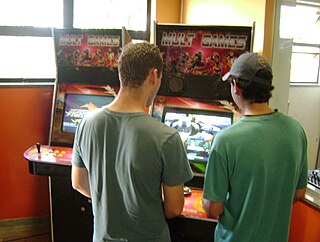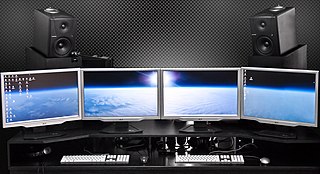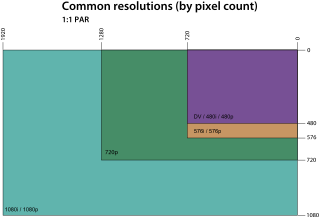
A cathode-ray tube (CRT) is a vacuum tube containing one or more electron guns, which emit electron beams that are manipulated to display images on a phosphorescent screen. The images may represent electrical waveforms on an oscilloscope, a frame of video on an analog television set (TV), digital raster graphics on a computer monitor, or other phenomena like radar targets. A CRT in a TV is commonly called a picture tube. CRTs have also been used as memory devices, in which case the screen is not intended to be visible to an observer. The term cathode ray was used to describe electron beams when they were first discovered, before it was understood that what was emitted from the cathode was a beam of electrons.

A computer monitor is an output device that displays information in pictorial or textual form. A discrete monitor comprises a visual display, support electronics, power supply, housing, electrical connectors, and external user controls.

The Vectrex is a vector display-based home video game console - the only one ever designed and released for the home market, that was developed by Smith Engineering and manufactured and sold by General Consumer Electronics. It was first released for the North America market in November 1982 and then Europe and Japan in 1983. Originally produced by General Consumer Electronics, it was later licensed to Milton Bradley after they acquired the company. Bandai released the system in Japan.

Interlaced video is a technique for doubling the perceived frame rate of a video display without consuming extra bandwidth. The interlaced signal contains two fields of a video frame captured consecutively. This enhances motion perception to the viewer, and reduces flicker by taking advantage of the phi phenomenon.

Video Graphics Array (VGA) is a video display controller and accompanying de facto graphics standard, first introduced with the IBM PS/2 line of computers in 1987, which became ubiquitous in the IBM PC compatible industry within three years. The term can now refer to the computer display standard, the 15-pin D-subminiature VGA connector, or the 640 × 480 resolution characteristic of the VGA hardware.

A framebuffer is a portion of random-access memory (RAM) containing a bitmap that drives a video display. It is a memory buffer containing data representing all the pixels in a complete video frame. Modern video cards contain framebuffer circuitry in their cores. This circuitry converts an in-memory bitmap into a video signal that can be displayed on a computer monitor.
Apple Inc. has sold a variety of LCD and CRT computer displays since introducing their first display in 1980. Apple paused production of their own standalone displays in 2016 and partnered with LG to design displays for Macs. In June 2019, the Pro Display XDR was introduced, however it was expensive and targeted for professionals. In March 2022, the Studio Display was launched as a consumer-targeted counterpart. These are currently the only Apple-branded displays available.

The display resolution or display modes of a digital television, computer monitor, or other display device is the number of distinct pixels in each dimension that can be displayed. It can be an ambiguous term especially as the displayed resolution is controlled by different factors in cathode ray tube (CRT) displays, flat-panel displays and projection displays using fixed picture-element (pixel) arrays.
Flicker is a visible change in brightness between cycles displayed on video displays. It applies to the refresh interval on cathode ray tube (CRT) televisions and computer monitors, as well as plasma computer displays and televisions.

An arcade cabinet, also known as an arcade machine or a coin-op cabinet or coin-op machine, is the housing within which an arcade game's electronic hardware resides. Most cabinets designed since the mid-1980s conform to the Japanese Amusement Machine Manufacturers Association (JAMMA) wiring standard. Some include additional connectors for features not included in the standard.

Multi-monitor, also called multi-display and multi-head, is the use of multiple physical display devices, such as monitors, televisions, and projectors, in order to increase the area available for computer programs running on a single computer system. Research studies show that, depending on the type of work, multi-head may increase the productivity by 50–70%.

Radius Inc. was an American computer hardware firm founded in May 1986 by Burrell Smith, Mike Boich, Matt Carter, Alain Rossmann and joined by other members of the original Macintosh team like Andy Hertzfeld. The company specialized in Macintosh peripherals and accessory equipment. It completed its IPO in June 1990.

Mechanical television or mechanical scan television is an obsolete television system that relies on a mechanical scanning device, such as a rotating disk with holes in it or a rotating mirror drum, to scan the scene and generate the video signal, and a similar mechanical device at the receiver to display the picture. This contrasts with vacuum tube electronic television technology, using electron beam scanning methods, for example in cathode-ray tube (CRT) televisions. Subsequently, modern solid-state liquid-crystal displays (LCD) and LED displays are now used to create and display television pictures.

An active shutter 3D system is a technique of displaying stereoscopic 3D images. It works by only presenting the image intended for the left eye while blocking the right eye's view, then presenting the right-eye image while blocking the left eye, and repeating this so rapidly that the interruptions do not interfere with the perceived fusion of the two images into a single 3D image.

Large-screen television technology developed rapidly in the late 1990s and 2000s. Prior to the development of thin-screen technologies, rear-projection television was standard for larger displays, and jumbotron, a non-projection video display technology, was used at stadiums and concerts. Various thin-screen technologies are being developed, but only liquid crystal display (LCD), plasma display (PDP) and Digital Light Processing (DLP) have been publicly released. Recent technologies like organic light-emitting diode (OLED) as well as not-yet-released technologies like surface-conduction electron-emitter display (SED) or field emission display (FED) are in development to supercede earlier flat-screen technologies in picture quality.
A multiple-sync (multisync) monitor, also known as a multiscan or multimode monitor, is a raster-scan analog video monitor that can properly synchronise with multiple horizontal and vertical scan rates. In contrast, fixed frequency monitors can only synchronise with a specific set of scan rates. They are generally used for computer displays, but sometimes for television, and the terminology is mostly applied to CRT displays although the concept applies to other technologies.

A monochrome monitor is a type of computer monitor in which computer text and images are displayed in varying tones of only one color, as opposed to a color monitor that can display text and images in multiple colors. They were very common in the early days of computing, from the 1960s through the 1980s, before color monitors became widely commercially available. They are still widely used in applications such as computerized cash register systems, owing to the age of many registers. Green screen was the common name for a monochrome monitor using a green "P1" phosphor screen; the term is often misused to refer to any block mode display terminal, regardless of color, e.g., IBM 3279, 3290.

CPT Corporation was founded in 1971 by Dean Scheff in Minneapolis, Minnesota, with co-founders James Wienhold and Richard Eichhorn. CPT first designed, manufactured, and marketed the CPT 4200, a dual-cassette-tape machine that controlled a modified IBM Selectric typewriter to support text editing and word processing.

A display resolution standard is a commonly used width and height dimension of an electronic visual display device, measured in pixels. This information is used for electronic devices such as a computer monitor. Certain combinations of width and height are standardized and typically given a name and an initialism which is descriptive of its dimensions. A graphics display resolution can be used in tandem with the size of the graphics display to calculate pixel density. An increase in the pixel density often correlates with a decrease in the size of individual pixels on a display.
The aspect ratio of an image is the ratio of its width to its height. It is expressed as two numbers separated by a colon, width:height. Common aspect ratios are 1.85:1 and 2.40:1 in cinematography, 4:3 and 16:9 in television, and 3:2 in still photography.





















